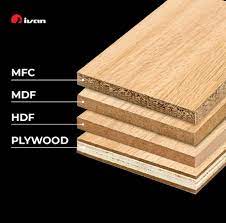What is MFC?
MFC, also known as Melamine Faced Chipboard. The word melamine is the resin used to create the decorative covering on the chipboard, making MFC.Melamine is a chemical compound combined with agents to form melamine resin, a durable thermosetting plastic. These characteristics give melamine board the ability to be made in an extensive range of colours and styles, such as replica wood textures and colours.
Why use Melamine Faced Chipboard (MFC)?
Smooth and easy to clean, Melamine doesn’t require paint or staining, saving you time and money. Furthermore, Melamine can be finished with fire-retardant capabilities, providing further benefits in commercial and residential applications.
Melamine is also is resistant to moisture, meaning you won’t have to worry about it warping over time. Additionally, It is also a cost-effective alternative to solid wood and is available in a wide range of colours and textures. MFC is manufactured to your size and shape specifications. Our state of the art machinery and shaped edge banding capabilities ensure the highest standard of the finished product.
Differences between wooden boards: MFC, MDF, HDF and Plywood
Industrial wood is a popular material widely used in furniture production today. In this article, we will explore the differences and applications of four common types of industrial wood.
MFC (Melamine Faced Chipboard): MFC is created by bonding wood chips from fast-growing trees like Eucalyptus, acacia, and rubber, forming particleboard and adding a melamine resin impregnated paper layer. The melamine layer provides waterproofing, scratch resistance, and enhanced aesthetics. MFC comes in various colors, is lightweight, and easy to work with. However, it is not seamless, has limitations in thickness, and is less resistant to water. MFC is suitable for home and office furniture in dry areas such as wardrobes, nightstands, and desks.
MDF (Medium Density Fiberboard): MDF is made by breaking down wood fibers from hardwood or softwood residuals, combining them with additives and resin binders, and forming them into panels under high temperature and pressure. MDF has a higher density than MFC and offers a smooth surface that is ideal for painting, gluing, and screwing. There are two processes - wet-process and dry-process - that produce different types of MDF. Ultra-light MDF is commonly used for indoor furniture such as filing cabinets and wardrobes, while moisture-resistant green MDF is suitable for humid areas like kitchen cabinets. Fire-retardant red MDF is often used in offices or apartments.
HDF (High Density Fiberboard): HDF consists of 85% natural wood combined with additives and binders. It features a smooth surface, moisture and scratch resistance, high rigidity, and load capacity. HDF securely joins with nails and screws, ensuring furniture durability. It is an ideal material for laminate flooring, doors, and high-quality home furniture like kitchen cabinets and wardrobes. However, HDF wood tends to have a higher price compared to MDF and MFC.
Plywood: Plywood is a wood-based panel material made from several thin layers of wood glued crosswise along the grain. It is produced in various qualities based on its intended use and the number of veneer layers. Plywood offers better water resistance than MDF and MFC. It finds applications both indoors and outdoors, serving as a building material, furniture sets, cabinets, and tables. Plywood is preferred for its high strength and stability.
Now, let's focus on the main differences between MFC and MDF:
Safety: MDF releases harmful particles, including formaldehyde, when cut or damaged, posing health risks. MFC, on the other hand, doesn't have such safety concerns.
Stability: MFC is more stable than MDF, thanks to its engineered thick carcass panels. MDF, being made from wood waste products, is less stable.
Ease of Manufacture: MDF is relatively easier to cut and shape compared to MFC, which may require more time and effort. MFC orders may also have longer delivery times.
Density: MFC is lighter than MDF. MDF can encounter issues such as warping and swelling when exposed to moisture and can split when repeatedly screwed into the sides.
Overall, understanding the distinctions between these industrial wood types helps in selecting the most suitable material for specific furniture applications.













Comments